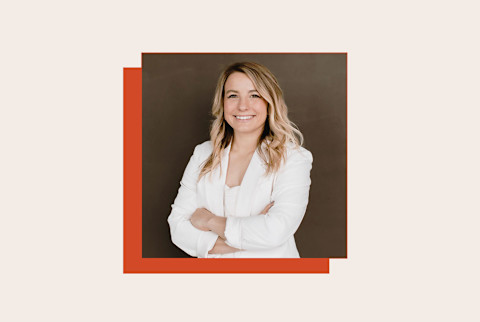3 Misconceptions About Women’s Fitness We Need To Stop Believing

For far too long, women have been pressured to cut calories, exercise solely for weight loss, and prioritize being smaller at any cost.
According to exercise physiologist, sports nutritionist, and founder of The Lyss Method training program, Alyssa Olenick, Ph.D., this harmful narrative has led to widespread energy deficits among women.
It's time to shift the goal from smaller to stronger. To drive this significant social change, Olenick emphasizes the need to dispel common misconceptions about women's fitness.
Below are three myths we discussed on an episode of the mindbodygreen podcast.
Myth: Carbs are the enemy
First off, let’s clear the air: Carbs are not the enemy. “I think a lot of people blame carbs for what high-caloric, hyper-palatable carb-fat combos did,” Olenick says, referencing items like pizza, macaroni and cheese, muffins, and other pastries.
While all of these foods are delicious and fine in moderation, Olenick encourages people to more often reach for what she calls “strict carbs”—the types of carbohydrates that provide energy and support recovery without added sugar and preservatives.
Some examples of strict carbs, she says, are fruit, juices, grains, and bread—all of which need to shed the bad reputation of being “unhealthy” carbohydrates.
Moreover, this consistent anti-carb rhetoric contributes to persistent energy deficits, especially among women. Olenick cites research on female athletes showing that low carbohydrate availability mimics some signs of low energy availability, suggesting that increased carb intake can help directly help to prevent energy deficiency1.
“If you have a high activity level or especially high cardiovascular training, your carb needs simply go up to match that,” she says.
This isn’t to say you can’t pair your carbohydrates with proteins—you should, Olenick says, but let this be a reminder that carbohydrates are not your enemy. They are your energy providers and a necessary part of a balanced, strength-supporting diet.
Myth: Taking creatine will make you gain weight
“Women are so afraid of taking creatine because they’re worried that it’s going to make them gain weight, make them heavier, bloat, whatever it is,” Olenick says. However, these fears have been filtered out and debunked in the research, she says.
When it comes to supplements, creatine is actually one of the more researched ingredients on the market, with studies supporting benefits like performance enhancement2, heart health protection3, and bone density4.
“We're starting to see more push for creatine research and how it might actually help us preserve muscle or bone with aging and menopause4 as well…and that's a time period where we're very sensitive to muscle loss5,” Olenick adds.
Beyond the muscle-related perks, creatine research is expanding into mental and cognitive health as well. It is proving to be a worthwhile way to enhance cognitive processing and brain function and support overall mood6.
With all of these benefits, it’s essential to squash the notion that creatine is only for men. “It was just always troped as like the guys the big beefcake bro bodybuilder supplement,” Olenick says—but not anymore.
Myth: You should always be doing high-intensity training
Given Olenick’s specialty in women’s fitness, she often gets asked, “How should men and women exercise differently?” Her response: “Men and women are different, but they’re not different species.”
By this, Olenick means that while men and women have slightly different fitness needs, many principles apply universally, regardless of sex or gender identity. One key principle is achieving balance in your fitness routine.
Olenick emphasizes that traditionally “male” workouts, such as heavy lifting and resistance training, can and should be incorporated into more women’s workout routines, particularly to support muscle longevity.
This means potentially dialing back the HIIT exercise classes to work in some additional strength training. While fitness classes are fantastic for building community and making exercise enjoyable, they can sometimes promote a toxic narrative that you should do high-intensity workouts every day with no rest, she says. This approach can inevitably lead to physical and even mental burnout.
For everyone, men and women, balancing intense effort with giving your muscles a break is not just recommended but an essential part of an optimized fitness routine.
As Olenick says in this episode about all things women’s fitness, “If we’re well-fed and well-trained and well-recovered, we can do so much.”
The takeaway
Olenick is on a mission to squash common myths around women’s health and fitness. She stresses the importance of “strict carbs” for lasting energy and recovery, considers creatine one of the most-researched supplements especially beneficial for women, and encourages everyone to seek a balance between high-intensity training and strength training for a well-rounded fitness regime.
For more tips and insights on women’s fitness, tune into the latest mindbodygreen podcast episode on Apple Podcasts—this is one you don’t want to miss.
6 Sources
- https://www.frontiersin.org/articles/10.3389/fspor.2024.1390558/full
- https://www.ncbi.nlm.nih.gov/pmc/articles/PMC5469049/
- https://www.ncbi.nlm.nih.gov/pmc/articles/PMC8067763/
- https://www.ncbi.nlm.nih.gov/pmc/articles/PMC7998865/
- https://www.sciencedirect.com/science/article/abs/pii/S8756328219301206?
- https://www.ncbi.nlm.nih.gov/pmc/articles/PMC7026167/
